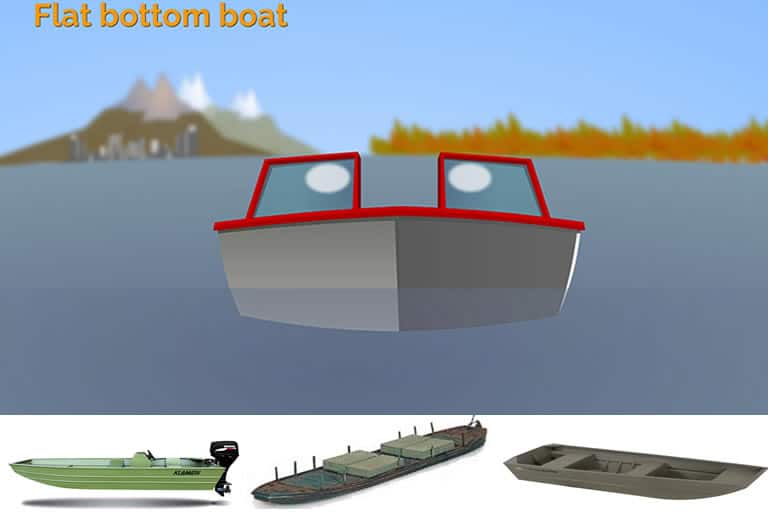Contents
What is a flat bottom boat?
A flat bottom boat is a water vessel with a flat bottom that is designed to traverse very shallow inland waterways.
The flat bottom makes it very stable in calm water and its shallow draft allows it to access bodies of water only a few inches deep.
Many flat bottom boats also have low freeboards.
This design has its strengths but also has its drawbacks.
What makes a flat bottom boat different from other boats?
To understand what makes a flat bottom boat different from other types of boat we need to briefly look at a few different boat designs.
Flat bottom boats differ from other types of boats mostly due to their hull design, their flat bottoms and their shallow draft.
For example, ocean going vessels and standard fishing vessels will usually have a v-hull shape, sometimes referred to as a deep v-hull.
This hull shape offers the most stability in rough water such as the ocean.
Ocean going vessels will also be equipped with a keel to stabilize the boat in rough water and give it a deeper draft.
The keel acts as a counterbalance below the boat.
There are also flat bottom boats that utilize a semi-v hull design.
A semi-v hull is designed to offer a boat better stability in rough water than a standard flat bottom boat but in a way that allows the boat to access shallower bodies of water than a full v-hull deep draft boat could.
A semi-v hull design is usually the preferred type for small flat bottom boats except in the case of some Jon boats where square bow is more common.
Some Jon boat owners, which are traditionally flat-bottomed, will modify their boats to create a semi-v hull because it offers them more stability in challenging waters.
This semi-v design allows the boat to navigate much choppier waters while ensuring the boat can still access fairly shallow waters.
However, all Jon boats are flat-bottomed shallow draft vessels.
Other boats may have a rounded hull. This type of hull moves easily through the water even at slow speeds and is commonly found on speed boats.
Pontoon boats and catamarans have a flat hull that floats on two or more inflatable pontoons.
The wide beam offers great stability.
Now let’s see how the hull design of a flat bottom boat differs from these other boat designs and how that design gives the boat a shallow draft for shallow water access.
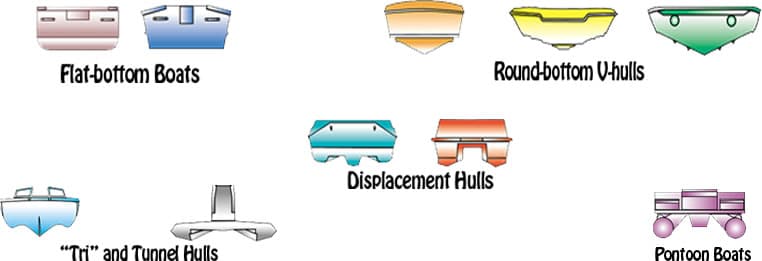
If you want a better understanding of the differences between deep draft and shallow draft (as well as the unique shoal draft) boats, read this article.
The flat bottom boat design
The design of a flat bottom boat varies depending on the style of boat being built.
However, all flat bottom boats share the same basic hull design which is the flat bottom that sits under the water.
This gives the boat a great amount of stability on calm water.
The flat bottom also means the boat has, what is known as a shallow draft, meaning it can access shallow bodies of water that boats with other hull designs could not access.
Some flat bottom boats, such as a Jon boat, can navigate waters that are just a few inches deep.
The flat bottom means the boat has less chance of snagging on obstacles like rocks or other debris on a riverbed or lake floor. Such obstacles would be hazardous to other types of boats with deeper drafts.
So what advantages does a flat bottom give a boat?
What a flat bottom boat is good for
There are many reasons for choosing a flat bottom boat over a boat with a different hull design.
The reason for choosing a flat bottom boat over a v-hull, semi-v hull or round hull boat will mostly depend on how you intend to use the boat and the environment in which you intend to use it.
Just as there are very good reasons for a person to choose a boat with a flat v-hull design, such as in the ocean, there are also very good reasons for choosing a flat bottom boat.
Let’s look at at some of the advantages and disadvantages a flat bottom boat offers to better understand why they are so useful.
Advantages of a flat bottom hull
A flat bottom hull, on a flat bottom boat, has a shallow draft that allows the boat to operate in very shallow water.
What is a shallow draft?
A shallow draft simply means that the bottom of the boat is not far away from the surface of the water.
Boats with a deep draft will have bottoms that extend much deeper into the water and these boats also usually have a keel which extends even further.
For example, most Jon boats can easily access bodies of water than are only a few inches in depth.
The shallow draft flat bottom means that the boat is much less likely to snag on obstacles at the bottom of shallow rivers and lakes.
To learn more about shallow draft and deep draft read this article.
In calm waters the flat hull also makes the boat much more stable than other hull designs.
The bottom offers a large flat surface which sits “on” the water rather than sitting deeply in the water thus offering greater stability.
The fact that the boat sits more on the water than in it means you get an exceptionally smooth ride even at high speed as the boat almost glides over the water encountering very little resistance.
These key advantages make flat bottom boats, like a Jon boat, very popular among freshwater anglers and hunters. Such boat users often have to take their boats into very shallow waters and who need superior stability for fishing and hunting.
The flat hull design offers the same advantages to gondolas and canal boats, that also navigate shallow bodies of water such as canals and narrow rivers, as well as commercial barges that operate in shallow rivers.

Disadvantages of a flat bottom hull
The very design characteristics that make a flat bottom boat perform so well in calm and shallow waters makes it a bad performer in rough waters and in adverse weather conditions.
In choppy water the flat hull offers very little stability and if the wind picks up the boat can become unstable.
Although some people do take flat-bottomed skiffs and Jon boats into the ocean a flat bottom boat is not seaworthy and using one in the ocean requires pre-planing and strict adherence to safety guidelines.
It can also take a lot more power to move a flat bottom boat at speed than boats with other hull types.
What is a flat bottom boat called? The 18 types of flat bottom boat
There are many different types of flat bottom boat that have many different functions and just as many different names.
The most common type of small flat bottom boat, which is mostly used for fishing, hunting and utility work, is a Jon boat.
To learn more about what a Jon boat is and what it is used for read this article.
However, there are many other types of flat bottom as listed below.
Below is a list of common flat bottom boats:
- Canal boat
- Barge
- Bateau
- Dory
- Durham boat
- Flatboat
- Gondola
- Jon boat
- Keelboat
- Narrowboat
- Norfolk punt
- Pirogue
- Pram
- Punt
- Pünte
- Quffah
- Sandolo
- Scow
- Trow
Let’s look at these boats in closer detail.
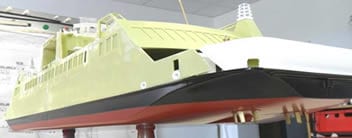
Canal boat
Canal boats are long somewhat narrow boats designed to navigate canals and rivers.
A narrowboat is a type of canal boat used mostly in Britain, Ireland and in parts of Europe. Because canals in the British Isles are shallow and very narrow this type of boat was designed to fit comfortably in the canal while maximizing freight capacity.
They are therefore very narrow and long giving them a unique look unlike any other type of boat.
Many canals in Europe, the USA and Canada are much wider than those in Britain and Ireland and so the canal boats used there are usually much bigger.
For more information about canal boats and narrowboats read this.
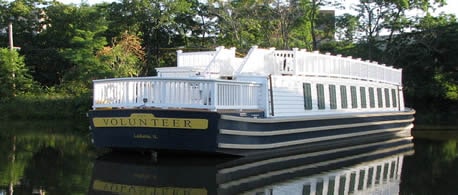
Barge
A barge is a flat-bottomed working boat that is mostly used in rivers and canals for the transportation of heavy goods.
Barges are one of the oldest boat designs and date back to ancient Egypt.
A modern barge can be self-propelled but many have no form of propulsion and must be towed or pushed by towboats.
In certain parts of the world canal barrages still operate the same way they have for centuries being towed by a horse or other animal which moves along the adjoining towpath.
Canal and river barges were the main transportation method used to move heavy goods prior to the introduction of trains.
The railway’s reduced prices, increased speed of delivery and expanding network (and more flexible delivery destinations) slowly phased out the popularity of barges.
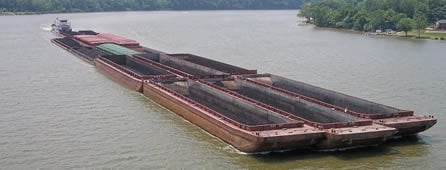
Bateau
A bateau is a flat-bottomed boat which was used extensively across North America, especially in the colonial period and in the fur trade. They date back as far as 1650.
A bateau boat was originally designed to be pointed at both ends but later morphed into a wide variety of different styles.
It is also known by its French name “bateau”, sometimes spelled “batteau”.
Bateau, is French for “boat”. “Bateaux” is the plural and the origin of the modern name.
In some Southern States of the USA, with a strong historically French connection, this term is also used to refer to Jon boats and other small flat-bottomed utility vessels to this day.
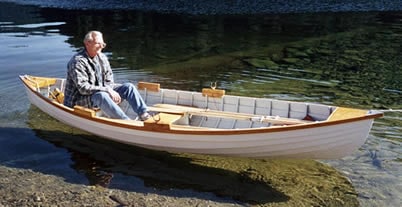
Dory
A dory is a flat-bottomed boat that has been used for centuries as a small fishing vessel.
These boats can be seen in action today fishing off the coast of Newfoundland in Canada and they are said to have originated in New England around the 18th Century.
The traditional Grand Banks dory was built to have straight sides, a straight bow, flat bottom, and narrow tombstone-shaped transom.
Although most flat-bottomed boats are not ideal for ocean use a traditional dory is actually well suited to ocean conditions.
Its narrow “tombstone” transom allows the boat to ride well on waves though it can be difficult to handle and unstable unless it has some weight in it (from a fishing catch for example).
There are many different variations of dory with boats having different design characteristics depending on the area in which it is used.
Dories evolved differently in different areas because the boat was adapted for use in local waters.
Modern dory designs have changed over the centuries and are now much more stable and easier to handle..
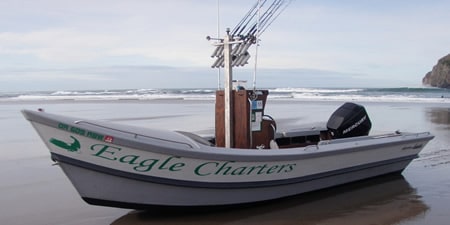
Durham boat
A Durham boat is a large, flat-bottomed and double-ended freight boat made from wood that was popular in North America during the 18th Century. It was used almost exclusively on inland waterways.
These boats were most associated with the Durham Ironworks of Durham in Pennsylvania, where they were used to haul freight along the Delaware River.
George Washington used Durham boats to transport troops on the Delaware River in 1776 during the American Revolutionary War.
They were slowly replaced by bigger canal boats as more canals were opened across the USA.
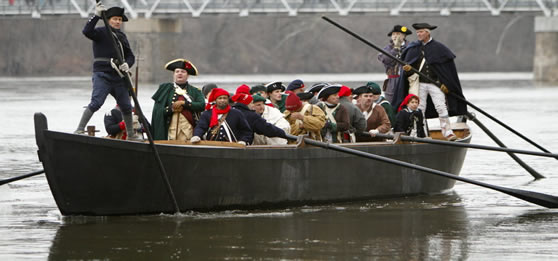
Flatboat
A flatboat was a wooden rectangular shaped flat-bottomed boat that had square ends. It was a transport vessel for both freight and people across inland waterways and used exclusively in the USA.
Flatboats came in different sizes though they were mostly large to accommodate heavy freight.
The unique design of a flatboat meant that it was almost always used only once.
Its only one-way trip down a river usually ended with its dismantling for lumber.
The first flatboat was made in 1781 at Old Redstone Fort on the Monongahela River by a pioneer and veteran of The American Revolutionary War, named Jacob Yoder.
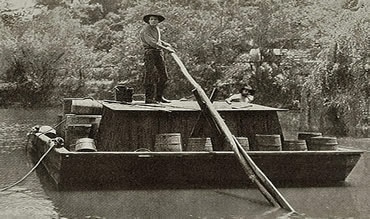
Gondola
A gondola is a common sight in Venice though they are used in other parts of the world. A gondola is a flat-bottomed boat propelled by a pole and was designed specifically to traverse the Venetian lagoon on which the city of Venice sits.
The gondolier both propels the boat and steers it via the unfastened rowing oar.
Traditionally, gondolas were the main method of transportation in Venice.
They still play a role in public transport today though in a much smaller capacity as modern water transportation is readily available.
The main role of modern Venetian gondolas is to carry tourists for a fee.
Similar gondola tourist rides are available in Las Vegas where gondoliers sing as they navigate the canals of the Venetian Hotel.
Although the history and even the inventor of the gondola has been lost we do know that a gondola boat was first mentioned in a letter from a Venetian Republic official back in 1094.
How long they had been in service up to that point no-one knows.
You can learn more about Gondolas in a separate article here.
Jon boat
These flat-bottomed utility boats are extremely popular across North America for their versatility and low purchase price.
A Jon boat is usually constructed of aluminum, fiberglass or wood.
Most homemade Jon boats are constructed from plywood as we show how to do here.
A Jon boat will usually have one, two, or three bench seats depending on its size.
These shallow draft boats are ideal for fishing and hunting in shallow inland waters.
A Jon boat hull is almost completely flat making it very stable in calm water but unstable in choppy conditions.
This flat hull design means the boat rides over the water rather than cutting through it as a v-hull or semi-hull does making them extremely comfortable to ride in.
Jon boats are usually powered by an outboard motor, oars or both.
There simple, yet effective, design makes them excellent utility boats and great for fishing and hunting especially in rivers and lakes where there are shallow areas.
The first Jon boat was probably built in 1904 by Charles Barnes (more on that below).
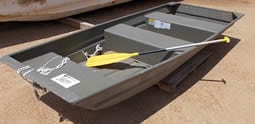
Keelboat
A keelboat is a flat-bottomed boat that has been traditionally used to ship cargo on rivers.
Their almost completely flat bottom means they are less likely to hit obstacles on the river bed in shallow areas.
In modern times these boats are often built as recreational sailing yachts though these yachts have fixed fin keels making them unsuitable for shallow waters.
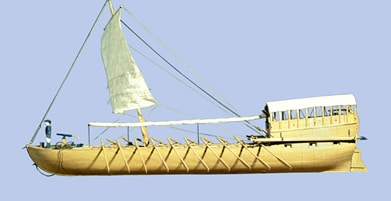
Narrowboat
Narrowboats are small barges that are used exclusively on canals.
They are very popular in Britain and Ireland.
Although a narrowboat can have a length between 30ft to 72ft it will never have a beam in excess of 7 ft.
This narrow beam ensures the boat can fit comfortably in the narrow man-made canals of the British Isles.
Although narrowboats are rarely used for commercial purposes in the modern age they remain very popular for vacations and also as alternatives to land-based homes.
In North America and parts of Europe larger canal boats are more common than narrowboats.
In the British Isles any canal boat that has a width greater than the standard 7ft narrowboat is considered a barge though in the USA most of these vessels are referred to as canal boats rather than barges.
You can read more about narrowboats here.
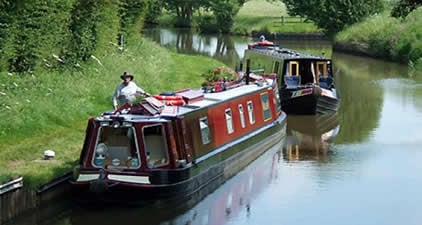
Norfolk Punt
A Norfolk Punt is a type of recreational yacht.
It is derived from the flat-bottomed gun punts that were propelled by a pole and used to hunt in shallow UK waters in the mid to late 1800s (see video below).
By the turn of the 20th century punters wanted a way to better navigate their hunting grounds, and to gain access to other areas more quickly.
So they began to alter their craft by adding both a mast and a sail for wind travel.
This was the birth of the modern-day Norfolk Punt.
From those humble beginnings we now have powerful racing boats that compete in events in the UK.
Pirogue
The name pirogue is a French word that is actually derived from the Spanish word “piragua”, which translates to “canoe”.
Pirogue does not actually refer to a canoe but is used as a generic term to describe any small flat-bottomed boats that were once used by French and Spanish colonists.
Pirogue boats are usually propelled by one-bladed paddles or, when used in very shallow waters, punted with a push pole.
Pirogues are sometimes equipped with small sails, though outboard motors are now more popular.
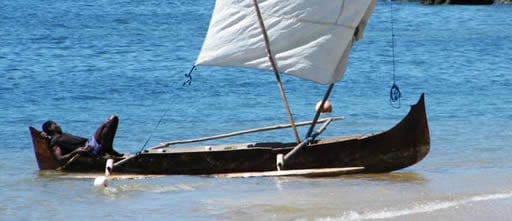
Pram
There are two different types of pram. One is a large ship and the other a small boat.
A ship pram, also spelled pramm, is a flat-bottomed ship with a shallow draft that was used across Europe in the 18th Century.
Prams were used in various wars around that time, such as the Napoleonic Wars, as their flat bottom shallow draft design allowed them to get much closer to the shore than other boats of the time.
A pram would be outfitted with with 10 to 20 deck guns and would have either two or three masts.
Prams were the type of transport Napoleon Bonaparte used to cross the English Channel.
The smaller pram is a very small flat-bottomed utility boat with transom and pointed bow.
Their flat bottom makes them excellent boats for use in shallow rivers and lakes.
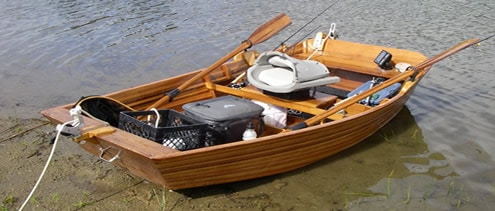
Punt
A punt has a flat bottom hull that makes it ideal for small shallow rivers, lakes and large ponds.
The boat has a square-cut bow and is also square at the stern.
Many people mistake a punt for a gondola but they are completely different; a gondola has a completely different structural design and is propelled by a single oar while a punt in propelled by a pushing pole along the riverbed or canal floor (see Norfolk Punt above).
Punts were originally built as cargo boats for fowling and angling and were sometimes just simple flat-bottomed platforms. The origins of the punt stretch back to their use in narrow, shallow waters for transporting cargo, hunting wildfowl, fishing and reed-cutting.
These days punts are used purely for recreational purposes and are popular across the world.
It was not until the river trade was replaced by rail transport that recreational punting established itself as a trend. This happened first along the River Thames in the late 1860-1880’s and then across Britain before gaining popularity further afield.
Pünte
A pünte is a German flat-bottomed river boat that has no self-propulsion and is usually hauled or pulled, from one side of a body of water to the other, via a permanently stationed rope.
They are usually used to transport people and equipment across small bodies of water where a bridge is not available.
The pünte was used for centuries before it suffered a slow but steady decline in use. However, in recent times these watercraft are seeing a comeback in certain areas of Germany and the Netherlands.

Kuphar
A Kuphar is a circular flat-bottomed boat that was traditionally used on the Tigris and Euphrates rivers in ancient Mesopotamia, making the design thousands of years old.
It is still used today to transport a range of fresh produce and is sometimes used to transport people.
The word “Kuphar” comes from the Arabic word “quffa” which means basket and that is literally what the boat looks like. This is also why a Kuphar is sometimes known as a Quffa.
A Kuphar boat is propelled by either paddle or pole depending on water depth.
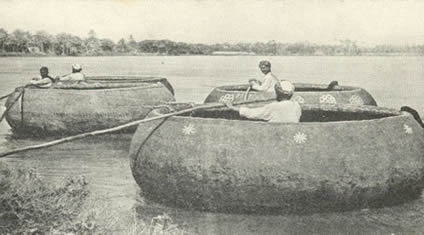
Sandola
Sandolas are traditional Venetian boats that are often confused with gondolas. However, a sanolda has a much simpler design than a gondola.
A sandola is also lighter and smaller than a gondola.
A sandolda is rowed with a single oar by an oarsman who stands up although it can be fitted with a sail and/or an outboard motor.
A sandola has a pointed and decorated metal nose. You can easily tell the difference between a gondola and sandola because the sandola will not have benches nor a high steel prow.
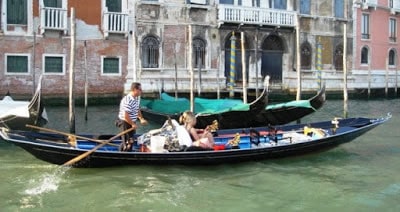
Scow
What is a scow boat? A scow is a flat-bottomed sailing boat designed to be capable of sailing in shallow bays and rivers.
Traditional sailing boats are fitted with keels and v-hulls which makes them much more stable in open water and choppy conditions, but this makes them unable to navigate shallow waterways.
In the days when shipping was the only way to transport goods across open bodies of water the deep draft design of ocean-going vessels meant that offloading the cargo of a sailboat required suitable docking areas or the use of smaller vessels to ferry the goods to shore.
The flat bottom hull on scows though, allowed this boat to not only navigate shallow waters like rivers but it could even be beached for the loading and unloading of goods.
This unique capability of the scow seen it grow in popularity because it was the most efficient way of moving cargo to inland regions where ocean-going vessels could not reach.
The advantage the scow had for inland waterway navigation, like all flat bottom boats, gave it a disadvantage in open water and made it unseaworthy for ocean use.
The scow was invented by J.O. Johnson, in 1895, and found acclaim when a scow entered by Johnston in the 1896 Yacht Club race annihilated the competition.
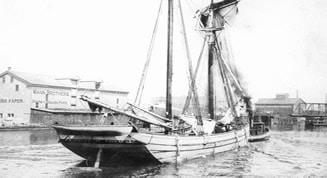
Trow
The trow is the last flat-bottomed boat on our list. A trow was a type of cargo boat that was used for the transportation of goods on the rivers Severn and Wye in the UK.
Trows were fitted with a mast that could be lowered to allow easy access under bridges.
A trow is one of the rare flat-bottomed boats that was actually seaworthy.
A flat-bottomed trow was able to sail the ocean by hauling a 20-foot (6.1 m) log of wood under the hull strapped with chains which acted as a temporary keel.
Modern trows are usually small recreational vessels.
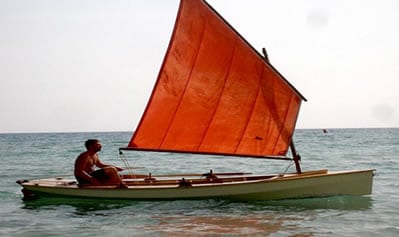
How stable is a flat bottom boat?
Due to their shallow draft and lack of keel many people wonder how stable a flat bottom boat is.
A flat bottom boat is very stable in calm water.
However, if conditions get choppy a flat bottom boat can become unstable.
In open ocean water with bad weather it can be downright dangerous to be in a flat bottom boat especially a small Jon boat.
Although some people do use unmodified flat bottom boats, such as Jon boats, for ocean fishing it is only safe to do so if the weather conditions are fine and waves are at a minimum.
We covered this subject in detail in the article Can Jon Boats go in the Ocean.
Popular flat-bottomed boats used for fishing and hunting on inland waters are also only stable in optimal weather.
To combat these limitations some Jon boat owners will take steps to stabilize a Jon boat using the techniques we outlined here.
You can read more about the stability issues associated with flat bottom boats and how to tackle them in this article.
Why buy a flat bottom boat?
If you intend to boat in bodies of water that are shallow, or that have large shallow areas, then a flat bottom boat is the best choice.
For instance, if you like sailing down wide shallow rivers or in large inland lakes that have extensive shallow areas then a flat bottom sailboat, like a scow or flat-bottomed skiff, would be a great advantage.
If you need a cheap utility boat, to freshwater fish or duck hunt, then a Jon boat would be an excellent choice.
We outlined the many benefits of using a Jon boat in this article.
Flat bottom boat history
Who invented the flat bottom boat?
It is unknown who built the first flat bottom boat but this hull design has been in use for thousands of years and dates back as far back as ancient Mesopotamia and ancient Egypt.
The modern Jon boat, arguably the most popular flat bottom boat in North America, dates back to pioneer times.
It is unknown who exactly invented it though there are strong indications that Charles Barnes from Missouri may be responsible for building the first Jon boat in 1904.
Even if Barnes did not actually invent the Jon boat he was certainly a major influence on its development.
For a history of the other types of flat bottom boat review the sections on each one above.

